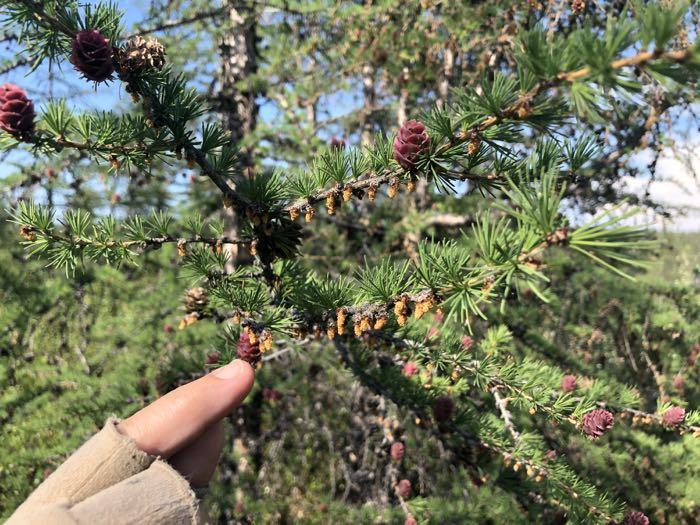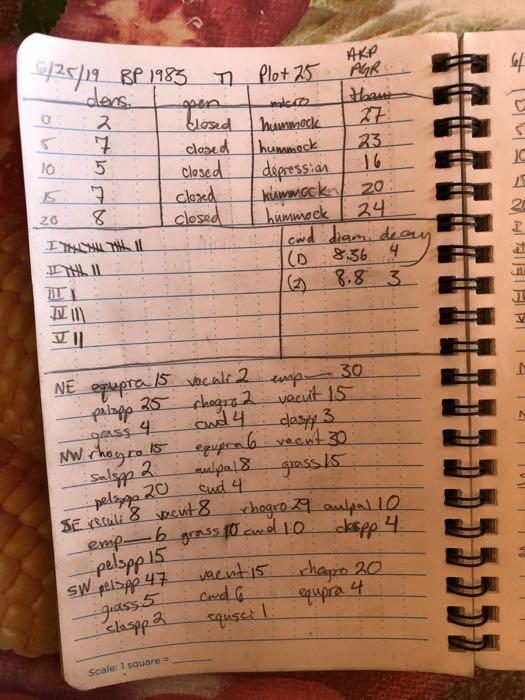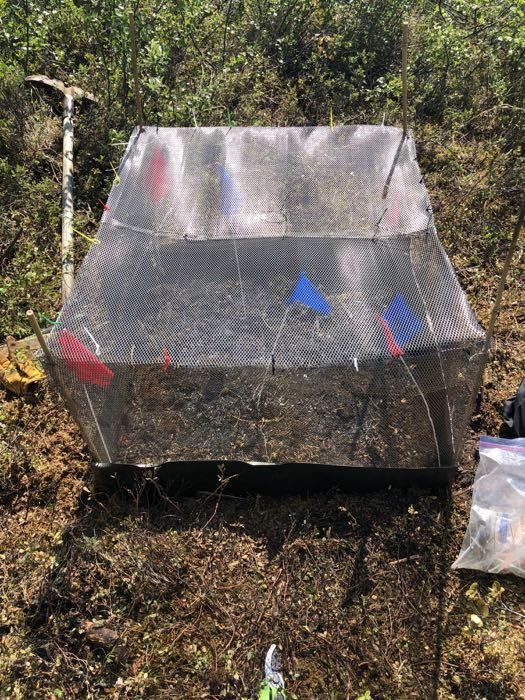The Importance of Teacher/Researcher Collaboration
Collaboration such as this offers a window into the science rarely seen by teachers and their students. It allows the public/students to experience, in real-time, relevant data collection of the 21st century. Furthermore, experiences such as these demonstrate the universal factors of the scientific process. It does not matter if we are practicing science in our classrooms, or out in the field, similar steps should occur: Observe, Question, Hypothesize, Design, Collect Data, Analyze, Conclude, Share, Repeat.
Moreover, these collaborations show that each part of the scientific process does not occur in isolation and it is rare that every step goes flawlessly. Hiccups in the field occur and that is okay! Even in real science, it is okay for things to go wrong. The key is adapting to those situations. This message is colossal in sharing with students who may struggle in their journeys of scientific exploration.
 Collecting vegetation for competition experiment photographed by Jennie DeMarco
Collecting vegetation for competition experiment photographed by Jennie DeMarco
In a similar light, researchers benefit from having an educator on their team, as well. Educators offer scientists good practice in sharing and explaining their science to individuals who may not be experts in their field. Scientific communication can be challenging, but educators push scientists to exercise this skill. Educators may also offer new perspectives to the team and opportunities to share the science with uncommon audiences.
 Educator Amanda Ruland and researcher Jennie DeMarco overlooking a boreal forest photographed by Amanda Ruland
Educator Amanda Ruland and researcher Jennie DeMarco overlooking a boreal forest photographed by Amanda Ruland
The Science Explained
The Arctic is warming at twice the rate as the rest of the globe. Trends show fires in arctic boreal forests becoming more severe and more frequent. Larch trees, a key species of these forests, require “just right” conditions to survive and to thrive. How is larch recruitment responding to a changing fire regime? The science team has meticulously collected months’ worth of data in Siberian post-fire burn areas, and upon analyzing their data, hope to gather insight into this question.
 Siberian boreal larch forest photographed by Amanda Ruland
Siberian boreal larch forest photographed by Amanda Ruland
 Collecting vegetation data at transect photographed by Ali Paulson
Collecting vegetation data at transect photographed by Ali Paulson
Engaging the Community
To involve my students and community in this experience I approached it from a variety of angles. To engage younger crowds, I created an Arctic Instagram account, used solely for the Arctic-Siberian expedition. I also posted current events on Facebook. I provided presentations for students and community members, and I reached out through newsletters and competitions.
One competition in particular prompted individuals to design a flag for our expedition. The winning flag was flown in Siberia. This encouraged audiences to not only learn about the relevant research but also follow the expedition to see their flags flown. Additionally, I posted on the PolarTREC blog and broadcasted a live streaming informational session from the Siberian Arctic.
Now that I have returned from Siberia, I will continue to reach out to students, colleagues and community members in the coming months and years through lessons and presentations. My vision for this experience was to expose the small town of Saratoga, Wyoming to polar science, to prompt interest and intrigue. In many ways, that interest has been sparked and I will continue to stoke the fire while it is still hot.
 Winning Flags for "Fly your flag in the Arctic" Competition photographed by Amanda Ruland
Winning Flags for "Fly your flag in the Arctic" Competition photographed by Amanda Ruland
Linking PolarTREC to My Classroom
I have been to Siberia. I have worked with scientists. It is now my pleasure to foster an environment where my students can understand the relationships between the science transpiring in arctic boreal forests and the relationships those forests share with the Rocky Mountain region. I will use the scientific data collection practices used in Siberia to help my students become better scientists and hopefully spark intrigue, leading students to further engage in a scientific inquiry of their own.
My goal is to create Next Generation Science Standard (NGSS) aligned lessons that stress the importance of the scientific method, attention to detail, especially when designing experiments, and strategies for overcoming hurdles in the classroom and/or field.
My educational practice will be influenced by this expedition in that I now have the expertise to integrate new scientific practice into my classroom. Students will gain exposure concerning Arctic ecosystems, particularly boreal forests, and learn about larch tree recruitment. Further, students will learn techniques that reinforce the scientific method and can be transferred to other areas of scientific inquiry.
 Male/female larch cones photographed by Amanda Ruland
Male/female larch cones photographed by Amanda Ruland
 Data collection photographed by Amanda Ruland
Data collection photographed by Amanda Ruland
 Using a plot intercept to collect vegetation data photographed by Jennie DeMarco
Using a plot intercept to collect vegetation data photographed by Jennie DeMarco
 Seed predation exclosure photographed by Amanda Ruland
Seed predation exclosure photographed by Amanda Ruland
The Big Picture
Experiences such as these not only enlighten our students, granting opportunities to understand real scientific practice, but they enlighten our educators as well. They are crucial components to crafting effective, relevant, real-world lessons and, in turn, fostering future world changers. And in truth, isn’t that the goal for which we all strive?
 Boreal forest from above photographed by Amanda Ruland
Boreal forest from above photographed by Amanda Ruland
| Attachment | Size |
|---|---|
| Download Report1.81 MB | 1.81 MB |
